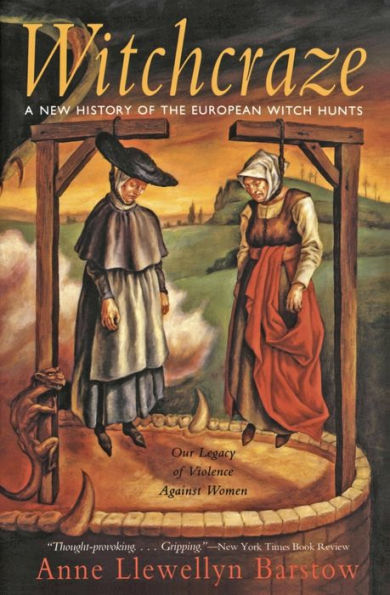Read an Excerpt
Chapter One
Why Women?
Gender, Numbers, Class
On average, witchcraft, the ultimate in human evil, was
sex-related to women in much the same proportion as
sanctity, the ultimate good, was sex-related to men.
— Christina Larner, Witchcraft and Religion
Joan Petersen, a healer, "was searched again in a most unnatural and barbarous manner by four women" supplied by her accusers, who found "a teat of flesh in her secret parts more than other women usually had." After bribed witnesses testified against her, she was executed.
Searching an accused woman's body for the devil's teat was one of the chief proofs of witchcraft. Though the investigation was normally done by women (and not done gently, as Joan Peterson's case demonstrates), the sessions were often witnessed by male court officials. When the constable of Salisbury, New Hampshire, undressed Eunice Cole to be whipped for witchcraft, he saw "under one of her brests.... A blew thing like unto a teate hanging downeward about three quarters of an inche longe not very thick." Men standing by saw him "rip her shift down"; moving in closer, they affirmed that Eunice "violently scratched it away," implying that she tried to remove the evidence from her body. When women were appointed to examine her further, they found instead "a place in her leg which was proveable wher she Had bin sucktt by Imps."
This lewd scene can set the tone for much of what will be investigated in this book. An analysis of violence such as this exposes the sexual terror and brutality at the heart of thewitch hunts, a topic too little discussed, The American historian Lois Banner has observed that two of the cultural norms specific to patriarchal society — war and rape — have been little studied by feminist scholars, and a third, pornography, studied only by feminists and not enough by them. In matters pertaining to the abuse of bodies, especially women's bodies, we have been strangely silent. To her comment I would add that writers on witchcraft also, feminist or otherwise, have tended to avoid the specifics of what happened to the bodies of the victims and have not asked aloud what difference it made that most of them were female. That historians to date, following traditional interests in legal and intellectual history, have concentrated more on the judges and theoreticians of the witchcraft trials than on the witches may explain this omission. But one must ask if revulsion at the public exploration as well as the torture of female bodies may also have caused them to make that choice.
Having a female body was the factor most likely to render one vulnerable to being called a witch. The sexual connotations and the explicit sexual violence utilized in many of the trials make this fact clear. Just which women were targeted and under what circumstances reveals much about the status of women in early modern Europe.
A Typical Witch
Reginald Scot, the English skeptic about witchcraft, began his definition of witches this way. "women which be commonly old, lame, bleare-eied, pale, fawle, And full of wrinkles." If Scot, who was sympathetic to the victims, perpetrated this negative stereotype, it is not surprising that witch hunters like Boguet and Remy used such phrases as "this miserable and damnable vermin" and "[like] a bitch far more hideous to look at than all the others."
Despite these venomous stereotypes, the records reveal that there can be no one definition of persons accused as witches: some, for example, were as young as eight or nine; others were in their prime; a few were male. Yet Scot's and the Frenchmen's caricatures capture the truth about the majority of persons accused of this crime: old, unattractive, disliked, and female.
From a trial in south Germany we find a portrait of a woman who typified the witch image, Walpurga Hausmanin of Dillingen. Walpurga, an elderly widow, supported herself by midwifery. Long suspect as a sorcerer ("twelve years ago she had killed at birth ... a girl child"; "ten years ago she had poisoned with her salve the second child of Anna Kromt"), Walpurga was finally brought to trial in 1587, charged with the deaths of over forty babies two women in childbirth, eight cows, a horse, and numerous geese and pigs. Her neighbors claimed also that she had caused three adults to languish to the point of death and had brought on a damaging hailstorm.
Finding the real Walpurga in this record is not easy, for it is a mix ofwords (given under duress), the judge's promptings, and the court her recorder's opinions. But despite the absurd elements in the story, we can learn a certain amount about this woman. The account states that "upon kindly questioning and also torture," she confessed to all these acts and explained that the powers by which she carried out these impressive maleficia (evil acts) were taught her by the devil, or to be exact, her devil-Lover "Federlin," who gave her the ointment that killed babies and caused women to deliver prematurely. Yet despite these fantastical elements and a description of flying to the devil's sabbat on a pitchfork, the account begins in a natural way, in the real world. Thirty-one years before, widowed but still in her prime, Walpurga, living in poverty and need, earned some money cutting corn for Hans Schlumperger. Attracted to his servant Bis in Pfarrhof, she enticed Bis "with lewd speeches and gestures," and he agreed to come to her house one night. She awaited him with "evil and fleshly thoughts," but was not Bis who came "but the Evil One in the latter's guise and raiment and indulged in fornication with her."
From that point on, the story followed a well-known pattern, familiarsurely to Walpurga from other witch trials.
Witchcraze. Copyright © by Anne L. Barstow. Reprinted by permission of HarperCollins Publishers, Inc. All rights reserved. Available now wherever books are sold.



